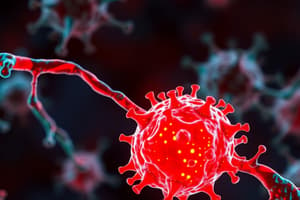Podcast
Questions and Answers
How do molecules of lipid and protein assemble into biological membranes?
How do molecules of lipid and protein assemble into biological membranes?
Molecules of lipid and protein assemble into biological membranes through a complex process involving the arrangement of hydrophobic and hydrophilic components.
What interactions occur inside animal cells in response to chemical signals?
What interactions occur inside animal cells in response to chemical signals?
- Junctions - connecting and joining cells together (correct)
- Recognizing - serving as cellular markers (correct)
- Transport - facilitating diffusion and active transport (correct)
- Enzymes - localizing metabolic pathways (correct)
- Anchorage - providing attachment points for cytoskeleton (correct)
Cell membranes with higher proportions of unsaturated phospholipids have higher fluidity.
Cell membranes with higher proportions of unsaturated phospholipids have higher fluidity.
True (A)
Cholesterol is embedded in the hydrophobic core of the phospholipid __________.
Cholesterol is embedded in the hydrophobic core of the phospholipid __________.
Match the functions of membrane proteins with their descriptions:
Match the functions of membrane proteins with their descriptions:
What is an example of a steroid hormone that passes through the membrane of target cells?
What is an example of a steroid hormone that passes through the membrane of target cells?
What is a key difference between transmembrane receptors and intracellular receptors?
What is a key difference between transmembrane receptors and intracellular receptors?
Signal transduction pathways initiated by receptors can lead to changes in gene expression.
Signal transduction pathways initiated by receptors can lead to changes in gene expression.
Signal transduction pathways often start a cascade of reactions in the ________.
Signal transduction pathways often start a cascade of reactions in the ________.
Match the following cellular responses with their outcomes:
Match the following cellular responses with their outcomes:
Study Notes
Cell Communication and Virology
Structure and Function of Cell Membranes
- Phospholipid bilayers have low permeability to large molecules and hydrophilic particles due to the hydrophobic hydrocarbon chains
- Cell membranes function as effective barriers between aqueous solutions
- Fluid mosaic model of membrane structure: molecules can move past one another
- Phospholipids have a glycerol backbone, two fatty acid tails, and a phosphate group
- Fatty acid composition affects membrane fluidity:
- Saturated phospholipids pack tightly, reducing fluidity, and have a higher melting point
- Unsaturated phospholipids pack loosely, increasing fluidity, and have a lower melting point
Cell Membrane Proteins
- Membrane proteins have diverse structures, locations, and functions
- Hydrophobic sections of proteins embed in the lipid layer, while hydrophilic sections are outside the membrane
- Functions of membrane proteins:
- Junctions: connect and join cells together
- Enzymes: localize metabolic pathways
- Transport: facilitated diffusion and active transport
- Recognition: marker for cellular identification
- Anchorage: attachment points for cytoskeleton and extracellular matrix
- Transduction: receptors for peptide hormones
Glycoproteins and Glycolipids
- Glycoproteins and glycolipids have carbohydrate chains extending into the extracellular environment
- Roles in cell recognition:
- Cell-cell recognition: important for tissue formation
- Antigen recognition: can act as antigens in a foreign body
- Glycocalyx: carbohydrate-rich environment surrounds cells and plays a role in cell-cell recognition
Cell Signaling
- Signaling molecules transmit messages from one cell to another
- Examples: hormones, neurotransmitters, immune chemicals, autoinducers
- Receptors: proteins with binding sites for specific signaling chemicals
- Ligand binding causes a conformational change in the receptor protein, initiating a cascade of reactions in the target cell
- Receptors are not permanently changed by ligand binding
Quorum Sensing in Bacteria
- Quorum sensing: ability to detect when the population is large enough for the group to function cooperatively
- Signaling molecules: autoinducers
- Quorum sensing allows bacteria to behave differently as a group, changing gene expression and behavior
- Examples: symbiosis in bobtail squid and Vibrio fischeri, biofilms, and pathogenicity
Differences between Transmembrane and Intracellular Receptors
- Transmembrane receptors: hydrophobic, embedded in the membrane, respond to hydrophilic signaling molecules
- Intracellular receptors: hydrophilic, dissolved in cytoplasm or nucleus, respond to hydrophobic signaling molecules
Initiation of Signal Transduction Pathways
- Signal transduction pathway: a series of interactions in the cell following ligand binding to a receptor
- Amplification of the signal: often involves 2nd messengers and cascades of reactions
- Cellular response: often changes gene expression
G-Protein-Coupled Receptors (GPCRs)
- GPCRs: transmembrane receptors that act like molecular switches
- Associated with G proteins, which consist of 3 subunits (α, β, and γ)
- Ligand binding causes G protein activation, replacing GDP with GTP, triggering a cascade of events and changing cell function
Studying That Suits You
Use AI to generate personalized quizzes and flashcards to suit your learning preferences.
Related Documents
Description
This quiz covers the structure and function of cell membranes, cell communication, and virology. It also explores how cells respond to chemical signals and distinguish between different signals.




